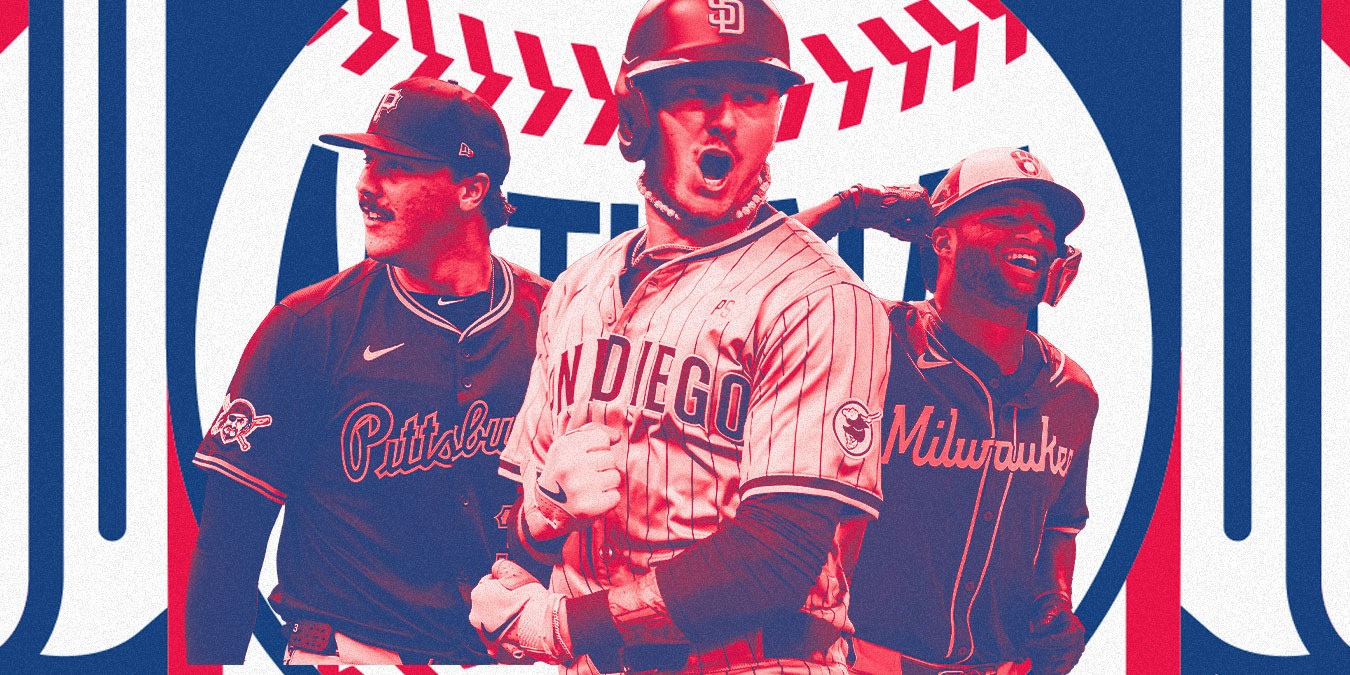Rookie of the Year is a simple award that inspires complicated calculus.
Though not prescribed, the imprecise art of projection inevitably enters the fray. It’s only natural to internalize the honor’s sense of a beginning, not an ending. It’s the only annual award for which voters feel compelled to look both ways before proceeding to vote.
This year, half a dozen sterling rookies typically worthy of consideration are showcasing their talents in the National League. At the front of that cosmic traffic jam that includes Shota Imanaga of the Chicago Cubs and Jackson Chourio of the Milwaukee Brewers are Pittsburgh Pirates pitching phenom Paul Skenes and San Diego Padres outfielder Jackson Merrill.
And there’s a lot of logic to unpack in what could be a close and long-discussed race for the best rookie.
Skenes, the No. 1 overall draft pick last year, debuted in May and started the All-Star Game for the NL in July. The major league game is experiencing a sort of power outage, with aces worthy of the “best pitcher in baseball” mantle dimmed by injury and decline.
In the throes of that disoriented shuffle through the dark, Skenes arrived and lit a lamp of hope with the electricity of 100 mph fastballs and 94 mph splinkers. He has made 20 starts, throwing down a sizzling 2.10 ERA and 151 strikeouts across 120 innings. He has the trajectory, the exposition to convince us a multiple Cy Young winner has arrived and should be treated as such.
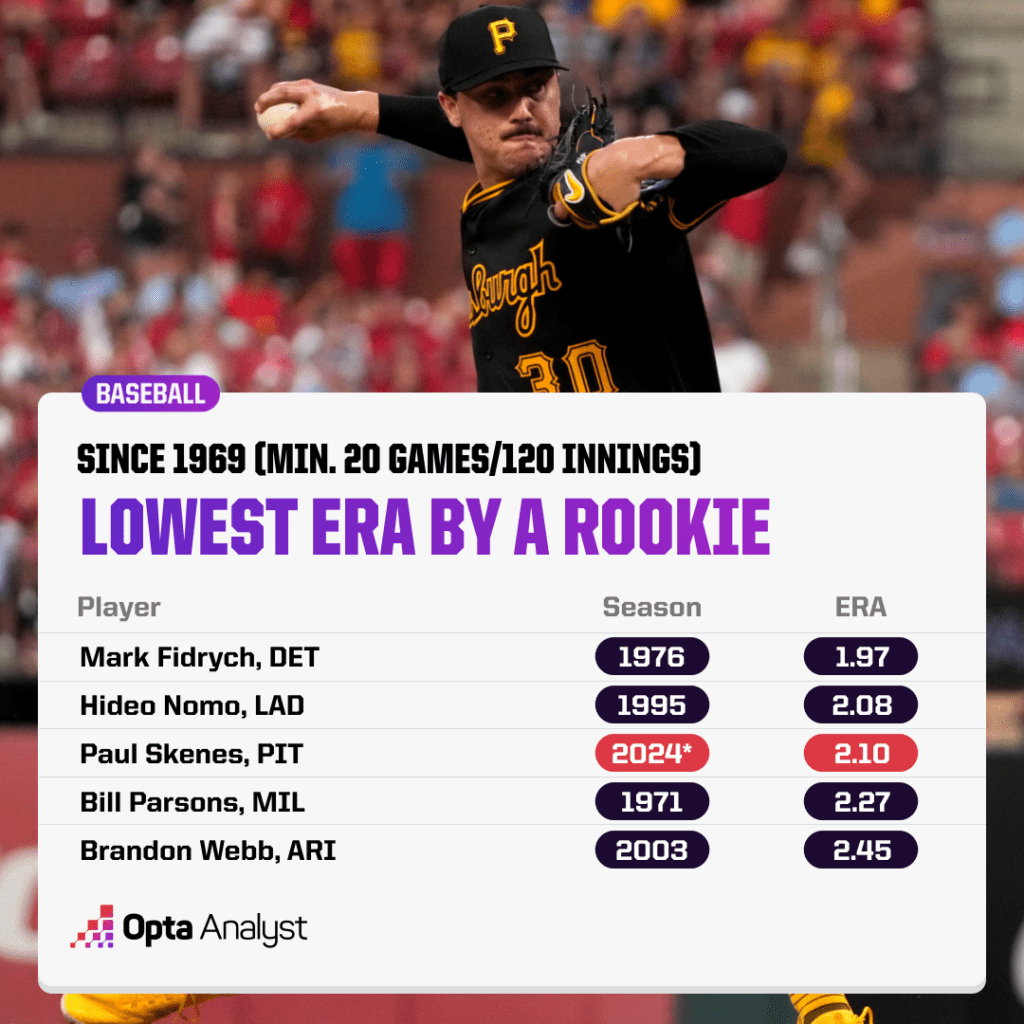
The buzz and the unknowable imprimatur of the next decade make a strong case for Skenes, who may thunder to another accolade, but the thrust of history makes a strong case for Merrill in the National League Rookie of the Year race, too.
A first-round pick out of high school in 2021, he made the Padres’ opening day roster ahead of his 21st birthday by learning center field on the fly. The former shortstop prospect has not only taken to center but tapped into significant pop at the plate.
His 23 homers in 141 big-league games have already surpassed his career minor-league total of 21 across 200 games. Merrill has done that without compromising his calling card – excellent bat-to-ball ability demonstrated by a .287 batting average and 17.5% strikeout rate.
Look one way, and you see Merrill weathering an imposing hitting environment far more effectively than his fellow rookies, portending his own arc toward the incredible. Look to the other, and you see another late-inning homer swinging San Diego’s hopes of a World Series run.
Look straight ahead, and you might see the NL Rookie of the Year.
In a lot of ways, Skenes’ warp-speed leap from college baseball to the All-Star Game helps elucidate the enormity of the challenge facing rookie hitters in the majors. Pitching talent in that realm just can’t be found in the minor leagues, not for long.
Coaches and front offices have been talking, in recent seasons, about the almost impossible task of preparing young hitters for the type of stuff they will see in the big leagues.
“You kind of have to see it to believe it,” Tampa Bay Rays hitting coach Chad Mottola told me last year, explaining why so many more hitters seem to require a longer adjustment period or even a return trip to the minors. In 2024, that list included consensus No. 1 prospect Jackson Holliday of the Baltimore Orioles.
That gap between minors and majors – with a complex mix of system causes explored by The Athletic’s Ken Rosenthal earlier this year – is increasingly evident in the numbers for hitters whose talent sends them blazing through the minors. Rookie hitters age 24 and under, typically the game’s top prospects, have seen their collective OPS across their first 50 career games steadily declining.
Debutantes from 2015 and 2016 had a .715 OPS in their first 50 games, coming close to the overall MLB averages of .721 and .739, respectively, in those seasons. And in 2019, such rookies posted a .735 OPS that made it four seasons with an OPS over .700 in five years.
Since then, however, under-24 rookies haven’t managed an OPS above .686 in their first 50 games. And the downward trend has continued in 2024, with their OPS at .623 — almost 100 points worse than the league-average .713 mark.
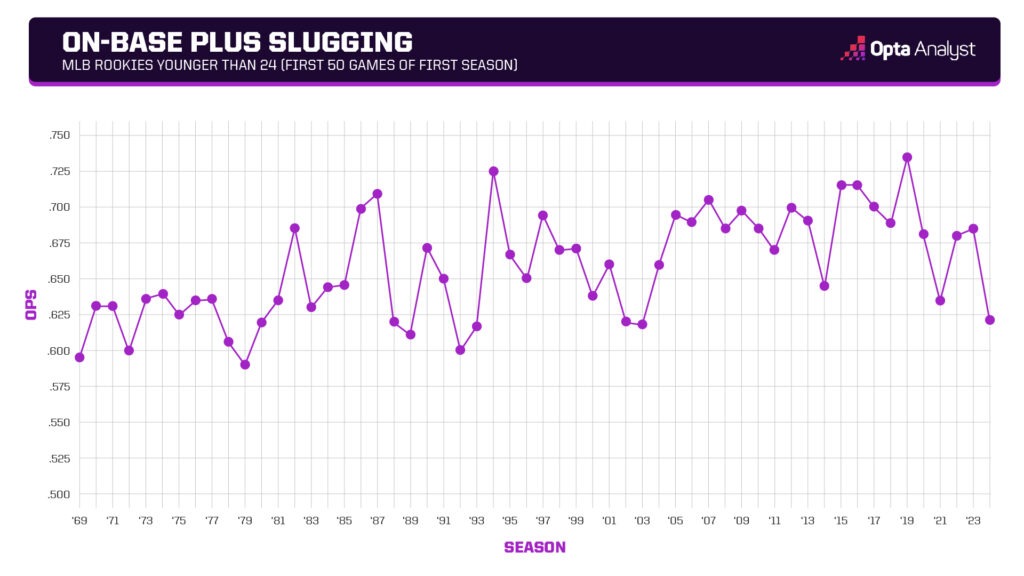
Merrill, who both skipped Triple-A entirely and leapt into the San Diego lineup while learning an entirely new defensive position, wasn’t immune to the adjustment period.
While his bat skills (good for an above-average 106 contact+) showed up immediately, Merrill slugged a lukewarm .360 in both April and May. In late May and June, he began tapping into the power that has elevated his game over other rookies. He has whacked 21 of his 23 homers since Skenes debuted on May 11.
That proclivity for damage has elevated his game. His 147 BIP+ now slots in ahead of NL MVP candidate Francisco Lindor and Pete Alonso of the New York Mets, the Atlanta Braves’ Matt Olson and Bryce Harper of the Philadelphia Phillies.
Only five hitters with Merrill’s above-average contact skills have better BIP+ marks — Vladimir Guerrero Jr. of the Toronto Blue Jays, Corey Seager of the Texas Rangers, Houston Astros slugger Yordan Alvarez, Salvador Perez and Bobby Witt Jr. of the Kansas City Royals.
“Jackson’s got a high baseball IQ, clearly has ability,” Padres manager Mike Shildt told Opta Analyst. “He has this ability, another skill set of his, to slow the game down, to see the game, understand what he’s about to face, let his talent take over, slow his heart rate down.”
The speed with which he consolidated his gains has elevated Merrill over his peers, even talented and highly touted ones.
With a 140 raw value+ (RV+) that ranks in the top 15 among all hitters with at least 400 plate appearances, Merrill is running a mile ahead of his closest rookie competition as a hitter (Andy Pages at 114 and Wyatt Langford at 110). The Orioles’ Colton Cowser, the favorite to win a less stratospheric AL Rookie of the Year Award over Austin Wells of the New York Yankees and
Wilyer Abreu of the Boston Red Sox, is at 104.
Where the sheer number of different hurlers working in the majors is one plausible explanation for hitters’ learning curve, Merrill is performing well with an opportunistic approach, leaning on a “see-ball, hit-ball” mindset available only to the wildly gifted.
“I treat it like when I was younger,” Merrill told Opta Analyst about his approach. “I never had info on guys before, you just go and play the game. It’s kind of the same way, but now I have extra info. I know what the ball’s doing before I even go up there.”
Maybe most impressively, Merrill has stayed one step ahead of pitchers in game-changing moments as the Padres fight tooth-and-nail for an NL wild-card spot and a return to the postseason.
Seven times, he has pulled the Padres into a tie or into the lead in the eighth inning or later, tied for second among all players in the majors. On six of those occasions, he did it with a home run – a feat no one in MLB can match this season. His two walk-off home runs came against Oakland Athletics flamethrower Mason Miller and esteemed New York Mets closer Edwin Diaz.
He’s also tied for third in the majors with seven home runs – behind only Anthony Santander of the Baltimore Orioles and Shohei Ohtani of the Los Angeles Dodgers – to go along with a .300 average and 15 RBIs in 70 at-bats in close and late situations. Those take place in the seventh inning or later with the batting team ahead by one run, tied, or with the tying run on base, at bat or on deck.
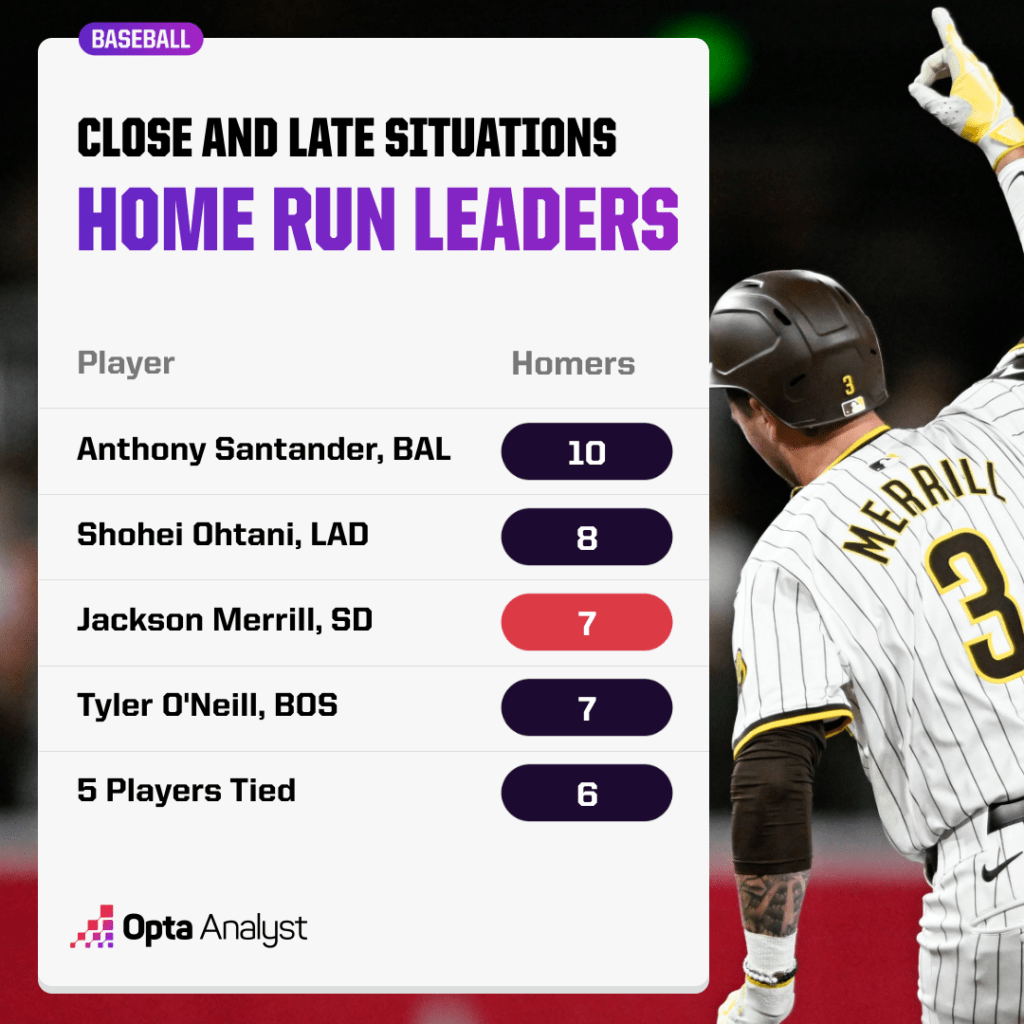
“One thing we’ve kind of adapted is really doing what the game calls for, and Jackson’s really good at that,” Shildt said. “He sees the situation, understands it, doesn’t make it bigger that it is, and his talent tends to come out.”
The easy argument would hold that any one of those crucial game-winning moments could make the difference for the Padres’ season. That Merrill’s presence and impact in the playoff race outweighs Skenes’ bombastic arrival on another no-go Pirates team. That Merrill’s 141 games and counting override Skenes’ 20 starts and 120 innings.
Let’s not pretend there’s any easy argument here, though. There are (at least) two worthy ROY winners to be anointed in the NL, and even the most prominent WAR models disagree on who has been more valuable.
Skenes electrifies viewers and will earn votes because he looks different. It’s possible he will raise the bar for young pitchers on multiple fronts – both his run prevention and his innovative use of the sinker-splitter hybrid are going to inspire envy.
Consider, however, that Merrill might look too familiar to deny. At age 21, he is outstripping Gunnar Henderson’s age-22 rookie season from 2023. His profile at the plate is almost a dead ringer for Witt Jr.’s peripheral numbers in the American League from a year ago, as the shortstop was preparing to catapult himself up onto the top rungs of the game’s elite talents.
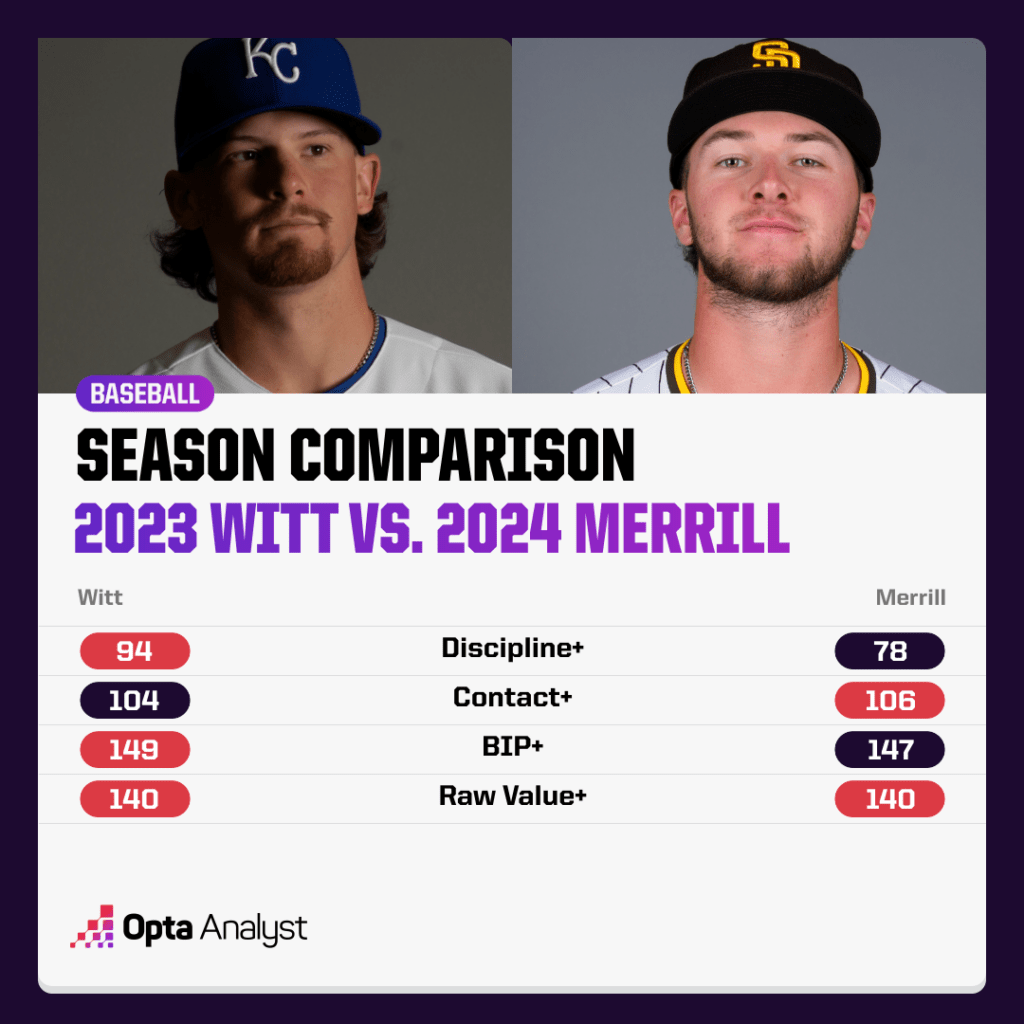
There’s nothing close to a guarantee Merrill will make similar strides. His education in the majors will certainly need to include a way to tone down some less advisable swings. Yet his evolution across a full season of play in 2024 – when so many other uber-talented prospects haven’t picked things up so quickly – suggests the shape of a superstar up-the-middle player.
That’s a beginning worth noticing.
Ryan Fagan contributed reporting and Jesse Abrahams provided research assistance. Be sure to check out our NFL, MLB, NBA, and college football coverage. And follow us on X, Instagram and Threads for more!
